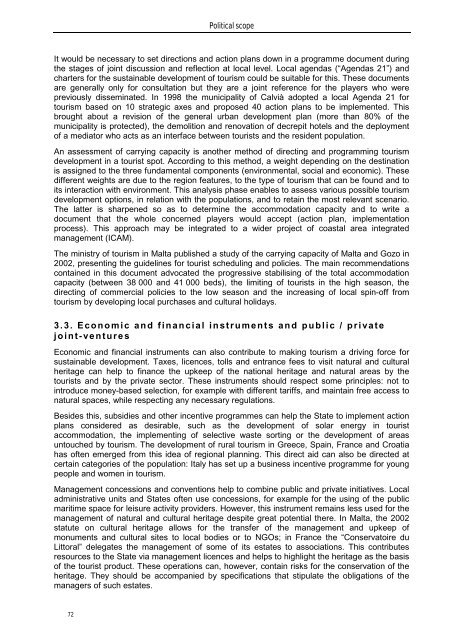dossier sur le tourisme et le développement durable
dossier sur le tourisme et le développement durable
dossier sur le tourisme et le développement durable
Create successful ePaper yourself
Turn your PDF publications into a flip-book with our unique Google optimized e-Paper software.
72<br />
Political scope<br />
It would be necessary to s<strong>et</strong> directions and action plans down in a programme document during<br />
the stages of joint discussion and ref<strong>le</strong>ction at local <strong>le</strong>vel. Local agendas (“Agendas 21”) and<br />
charters for the sustainab<strong>le</strong> development of tourism could be suitab<strong>le</strong> for this. These documents<br />
are generally only for consultation but they are a joint reference for the players who were<br />
previously disseminated. In 1998 the municipality of Calvià adopted a local Agenda 21 for<br />
tourism based on 10 strategic axes and proposed 40 action plans to be imp<strong>le</strong>mented. This<br />
brought about a revision of the general urban development plan (more than 80% of the<br />
municipality is protected), the demolition and renovation of decrepit hotels and the deployment<br />
of a mediator who acts as an interface b<strong>et</strong>ween tourists and the resident population.<br />
An assessment of carrying capacity is another m<strong>et</strong>hod of directing and programming tourism<br />
development in a tourist spot. According to this m<strong>et</strong>hod, a weight depending on the destination<br />
is assigned to the three fundamental components (environmental, social and economic). These<br />
different weights are due to the region features, to the type of tourism that can be found and to<br />
its interaction with environment. This analysis phase enab<strong>le</strong>s to assess various possib<strong>le</strong> tourism<br />
development options, in relation with the populations, and to r<strong>et</strong>ain the most re<strong>le</strong>vant scenario.<br />
The latter is sharpened so as to d<strong>et</strong>ermine the accommodation capacity and to write a<br />
document that the who<strong>le</strong> concerned players would accept (action plan, imp<strong>le</strong>mentation<br />
process). This approach may be integrated to a wider project of coastal area integrated<br />
management (ICAM).<br />
The ministry of tourism in Malta published a study of the carrying capacity of Malta and Gozo in<br />
2002, presenting the guidelines for tourist scheduling and policies. The main recommendations<br />
contained in this document advocated the progressive stabilising of the total accommodation<br />
capacity (b<strong>et</strong>ween 38 000 and 41 000 beds), the limiting of tourists in the high season, the<br />
directing of commercial policies to the low season and the increasing of local spin-off from<br />
tourism by developing local purchases and cultural holidays.<br />
3.3. Economic and financial instruments and public / private<br />
joint-ventures<br />
Economic and financial instruments can also contribute to making tourism a driving force for<br />
sustainab<strong>le</strong> development. Taxes, licences, tolls and entrance fees to visit natural and cultural<br />
heritage can help to finance the upkeep of the national heritage and natural areas by the<br />
tourists and by the private sector. These instruments should respect some princip<strong>le</strong>s: not to<br />
introduce money-based se<strong>le</strong>ction, for examp<strong>le</strong> with different tariffs, and maintain free access to<br />
natural spaces, whi<strong>le</strong> respecting any necessary regulations.<br />
Besides this, subsidies and other incentive programmes can help the State to imp<strong>le</strong>ment action<br />
plans considered as desirab<strong>le</strong>, such as the development of solar energy in tourist<br />
accommodation, the imp<strong>le</strong>menting of se<strong>le</strong>ctive waste sorting or the development of areas<br />
untouched by tourism. The development of rural tourism in Greece, Spain, France and Croatia<br />
has often emerged from this idea of regional planning. This direct aid can also be directed at<br />
certain categories of the population: Italy has s<strong>et</strong> up a business incentive programme for young<br />
peop<strong>le</strong> and women in tourism.<br />
Management concessions and conventions help to combine public and private initiatives. Local<br />
administrative units and States often use concessions, for examp<strong>le</strong> for the using of the public<br />
maritime space for <strong>le</strong>i<strong>sur</strong>e activity providers. However, this instrument remains <strong>le</strong>ss used for the<br />
management of natural and cultural heritage despite great potential there. In Malta, the 2002<br />
statute on cultural heritage allows for the transfer of the management and upkeep of<br />
monuments and cultural sites to local bodies or to NGOs; in France the “Conservatoire du<br />
Littoral” de<strong>le</strong>gates the management of some of its estates to associations. This contributes<br />
resources to the State via management licences and helps to highlight the heritage as the basis<br />
of the tourist product. These operations can, however, contain risks for the conservation of the<br />
heritage. They should be accompanied by specifications that stipulate the obligations of the<br />
managers of such estates.
















